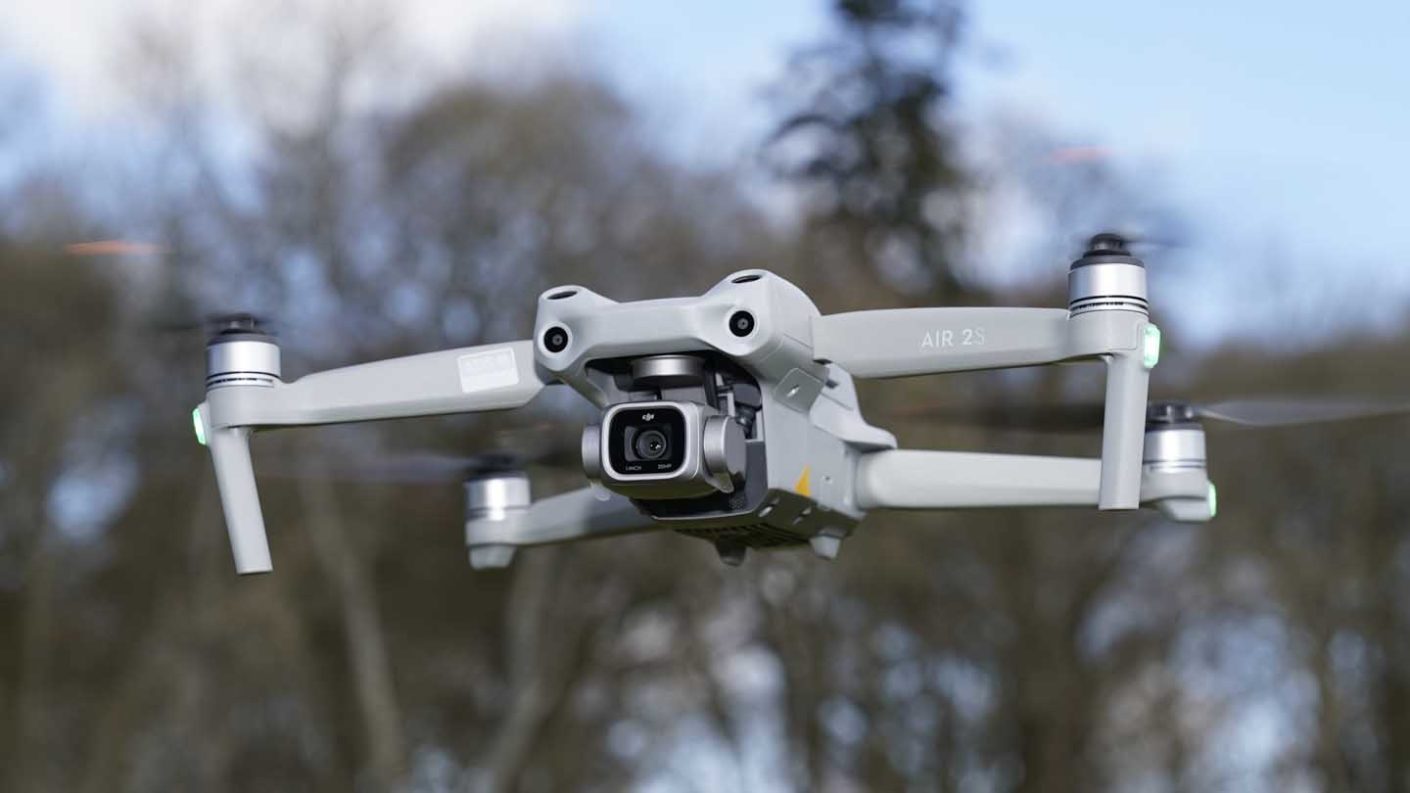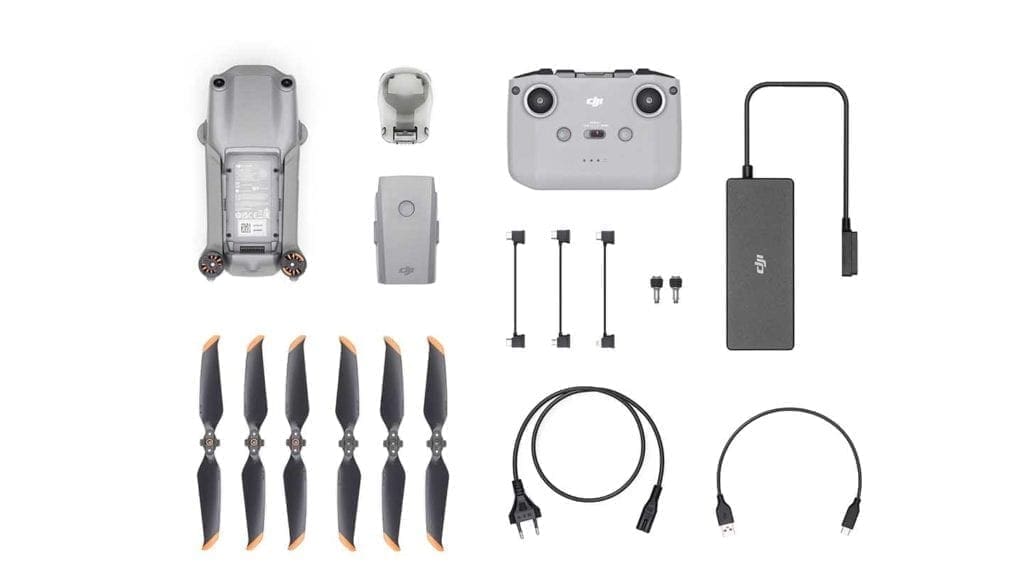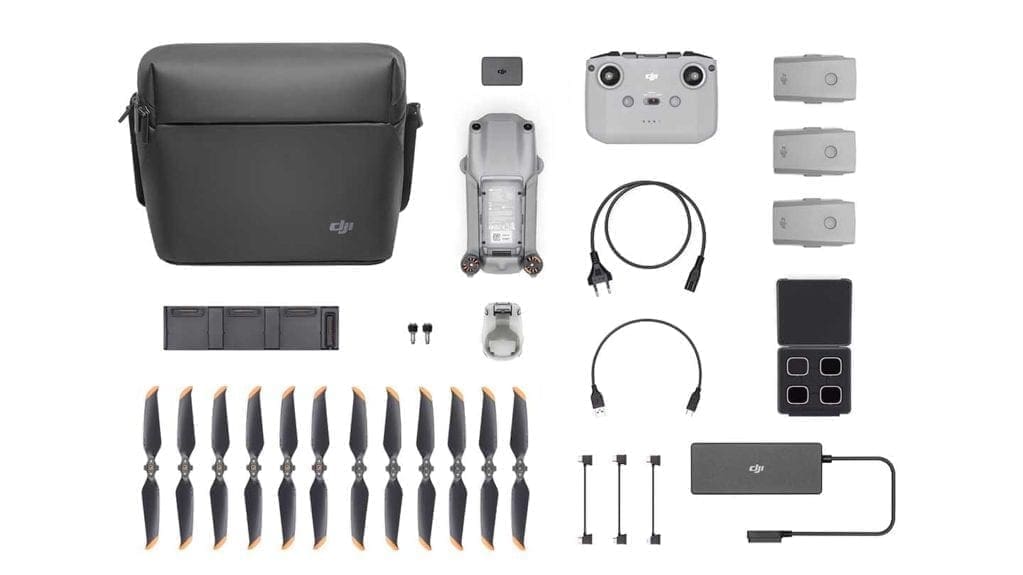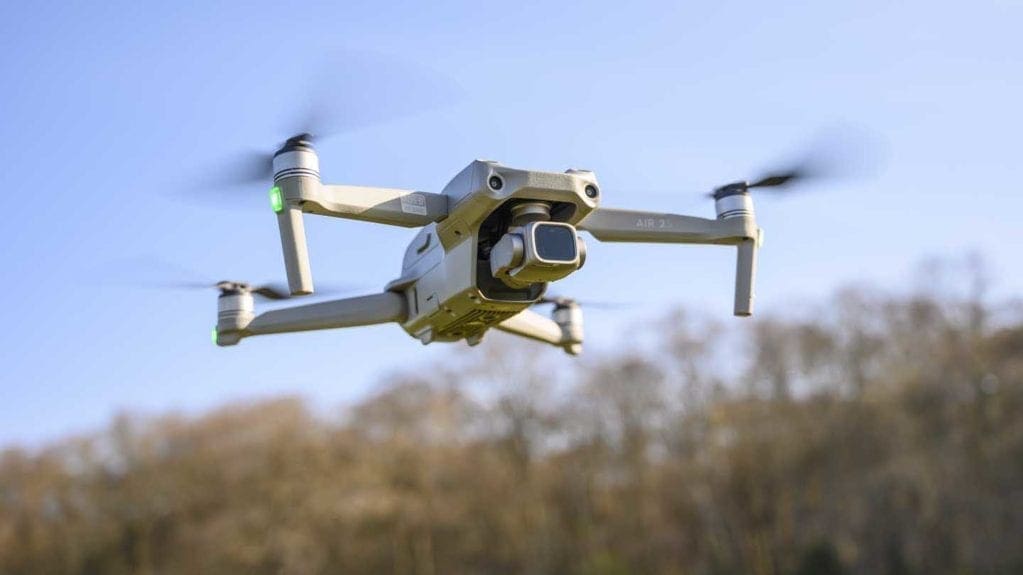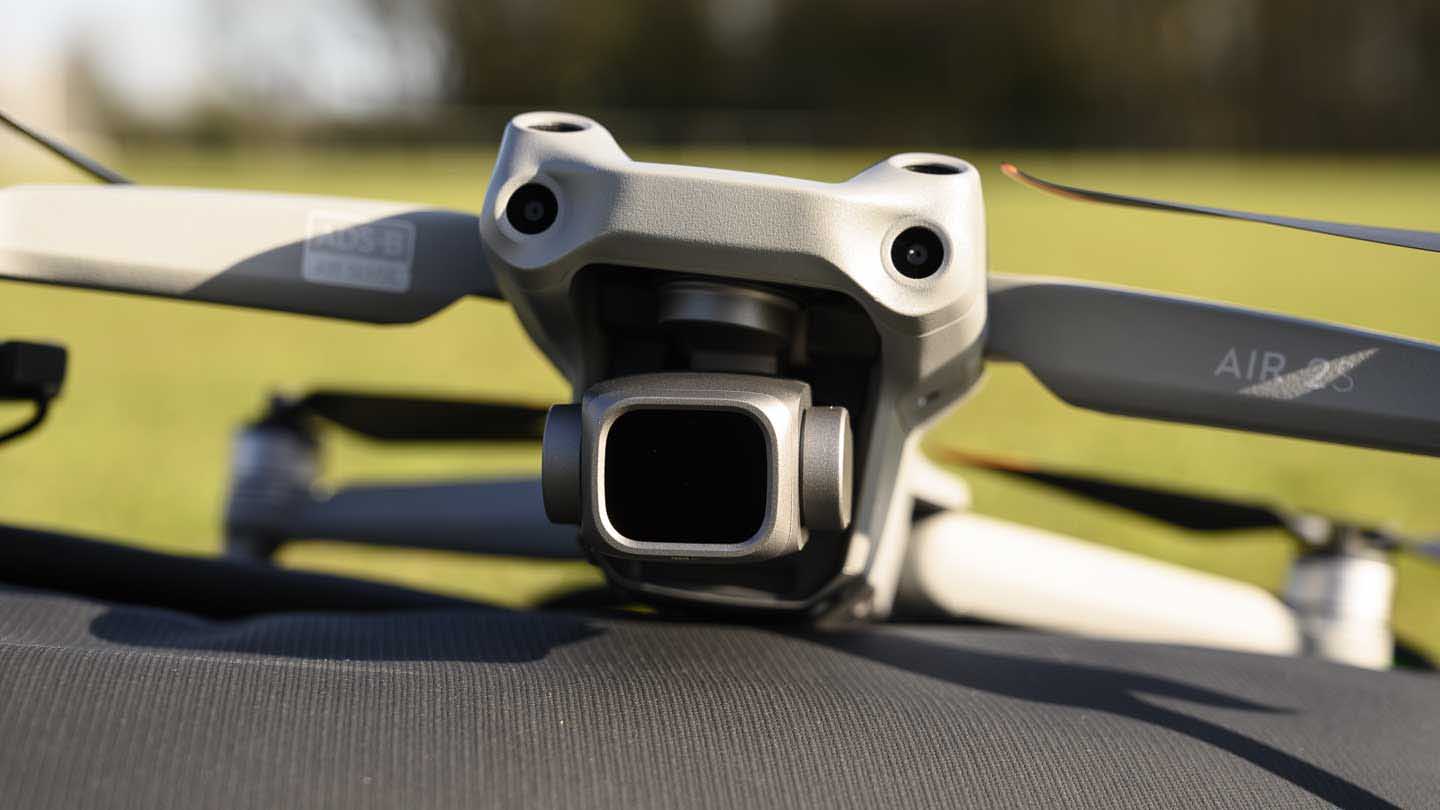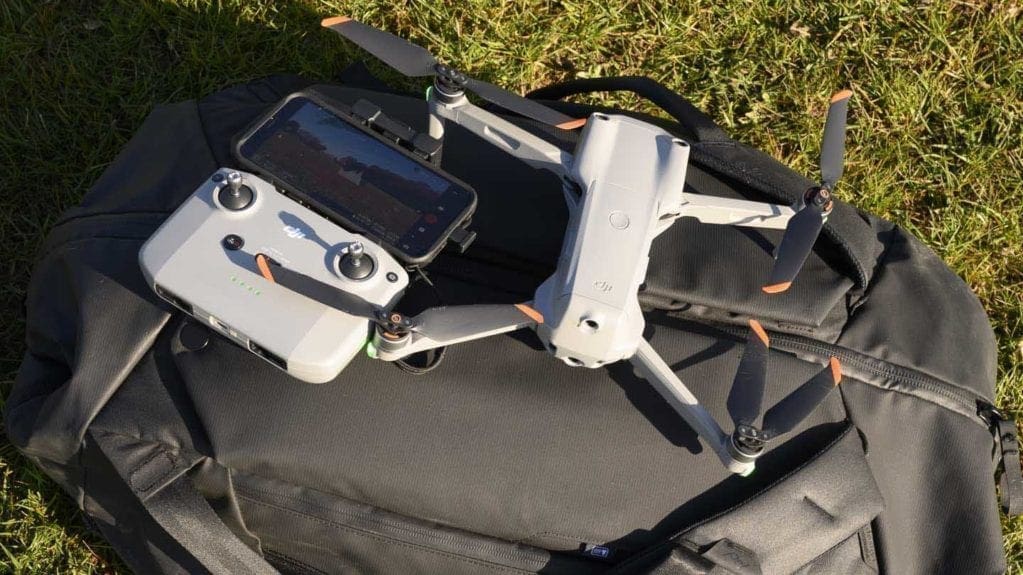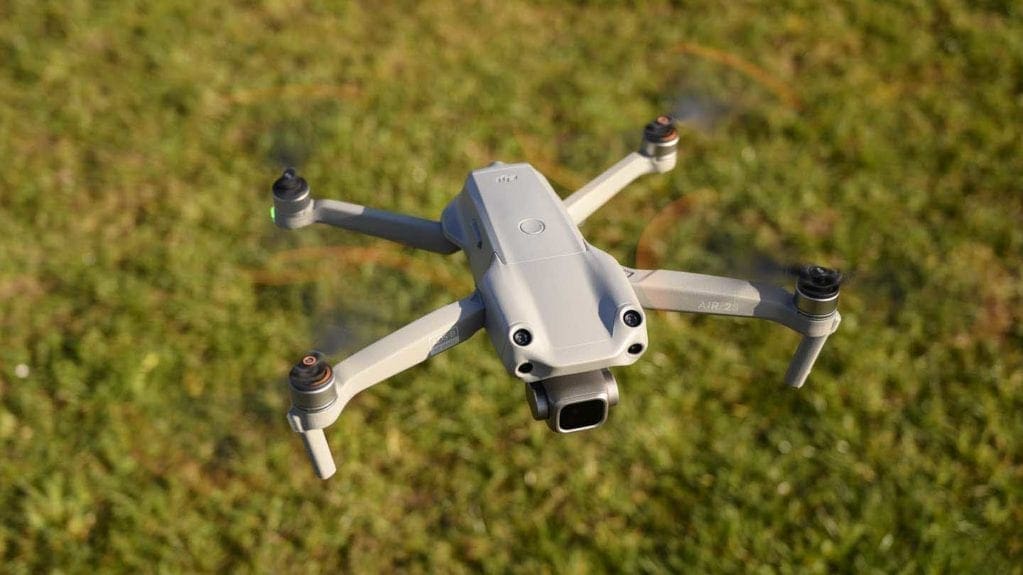As with the Mavic Air 2, the Air 2S’s fold-up prop arms work incredibly well, and when packed down ready for transport, they stay tightly in place. One issue, however, is that there should be a velcro wrap to stop the props from catching on the inside of backpack pockets when being removed.
In this review, we’ve looked at the Combo package, which features the drone, several sets of propellers, three batteries and a set of ND filters.
Each new generation of DJI Drone sees an increase in simplicity with the setup and use.
The DJI Air 2S is one of the simplest drones yet, around five minutes to install the prop, battery, card, power on, connect the app and run through all the checks.
Setup starts with installing the sticks into the controller, connecting your phone with the cable provided, opening the DJI Fly installed and signing in, then powering on the controller using the big button on the front.
With the controller primed and ready attention can turn to the DJI Air 2S; memory card in, props in place and battery inserted and again switch on.
A few seconds later the Air 2S comes alive, small lights flick on to show that everything is connected and working.
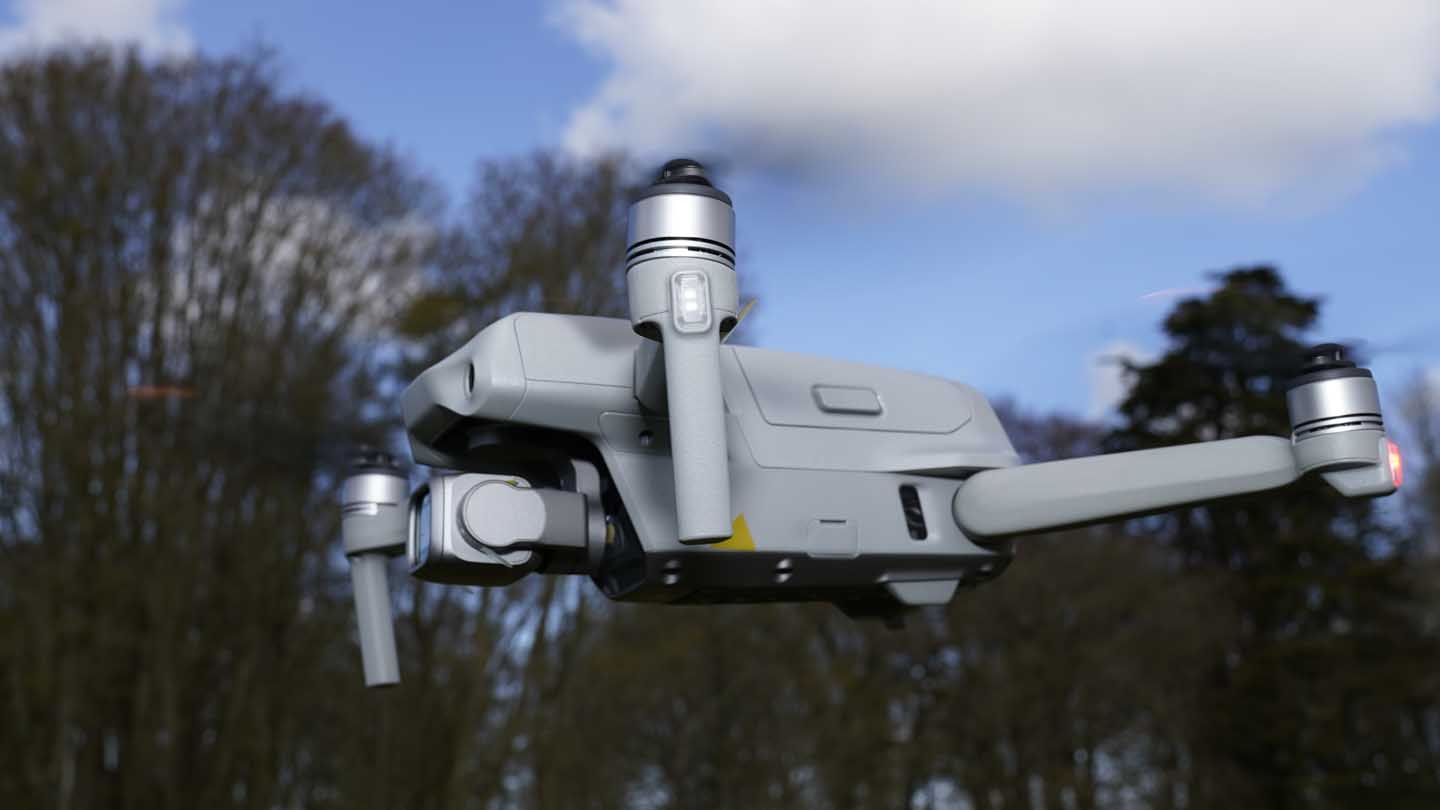
Flight mode
The DJI Fly app has evolved over the years, and there’s plenty of options to select flight characteristics and camera quality settings.
Finding your way around the interface is easy enough, even for those new to the system. As mentioned earlier, the main flight mode is selected on the physical controller with three options:
Cine: slow and carefully balanced for silky smooth cinematic style video shooting.
Normal: this balances speed and response and gives the drone the feeling that its on sky rails.
Sport: this is an interesting flight mode for the small drone as it doesn’t seem to make a great deal of difference to the speed, just 4m/s. Instead, Sport mode makes the drone more reactive; roll or yaw the drone too hard, and you’ll get it to sky drift. Ease off on the controls, and you get a small taste of drone flight of old, albeit on stabilisers.
At first launch and the Air 2S shows just how responsive the small drone is. Roll left, right, spin, up and down along with a few more manoeuvres, and everything checks out.
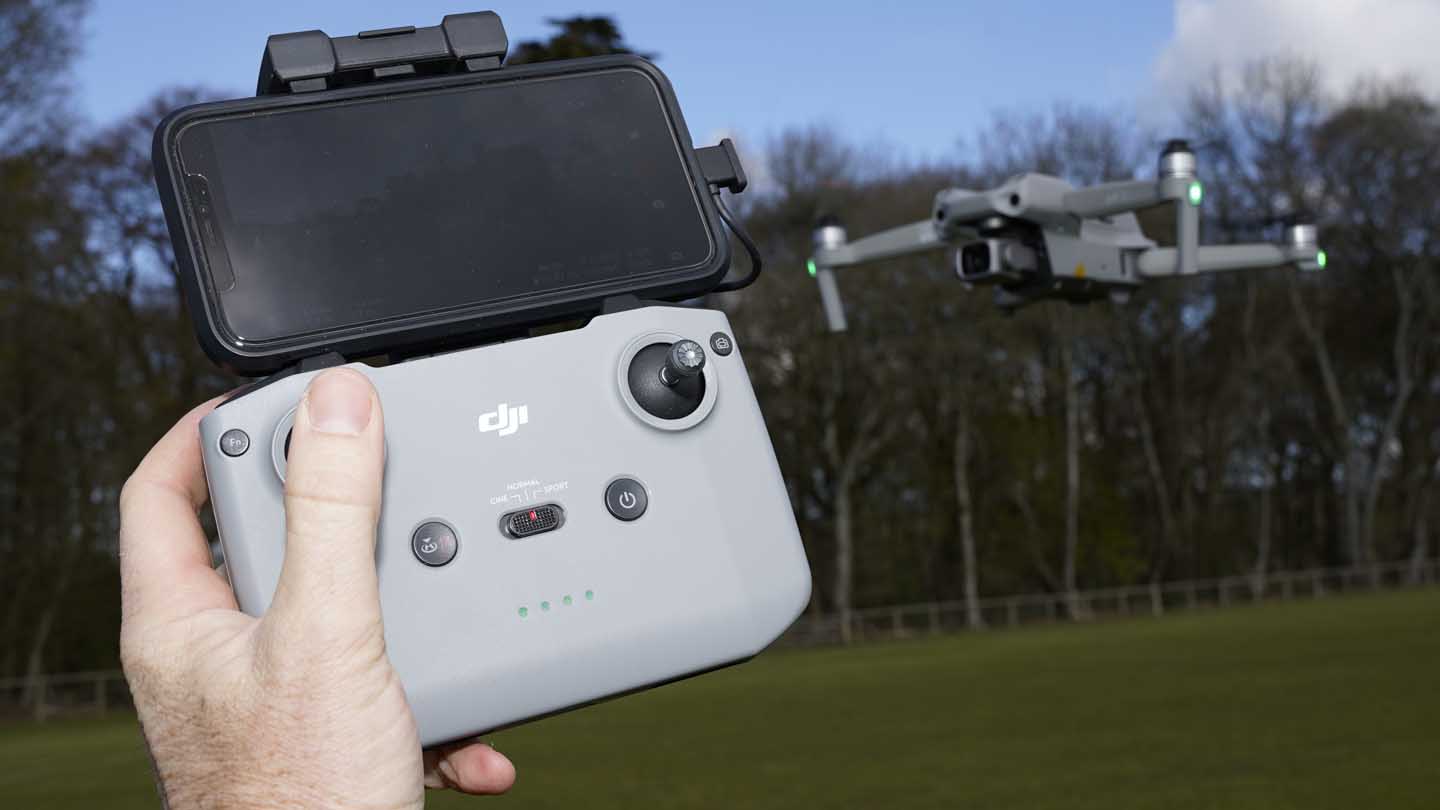
Taking control
Taking off and it’s good to feel the sticks’ balance. A good amount of resistance in each direction with a firm spring back to the central position.
Likewise, in-flight, the sticks’ natural movement is vertical or horizontal with a slight resistance if you push to the diagonal.
Cine is the new Tripod mode and enables slow, steady flight. One nice feature is that you can hot-swap between each flight mode with the drone still in the air.
So if you’re in Sports mode and see something you would like to film, slide the switch to Cine and off you go. There is no need to land, reboot, change the jumper on the control board, just one easy switch, and the flight characteristics change instantly.
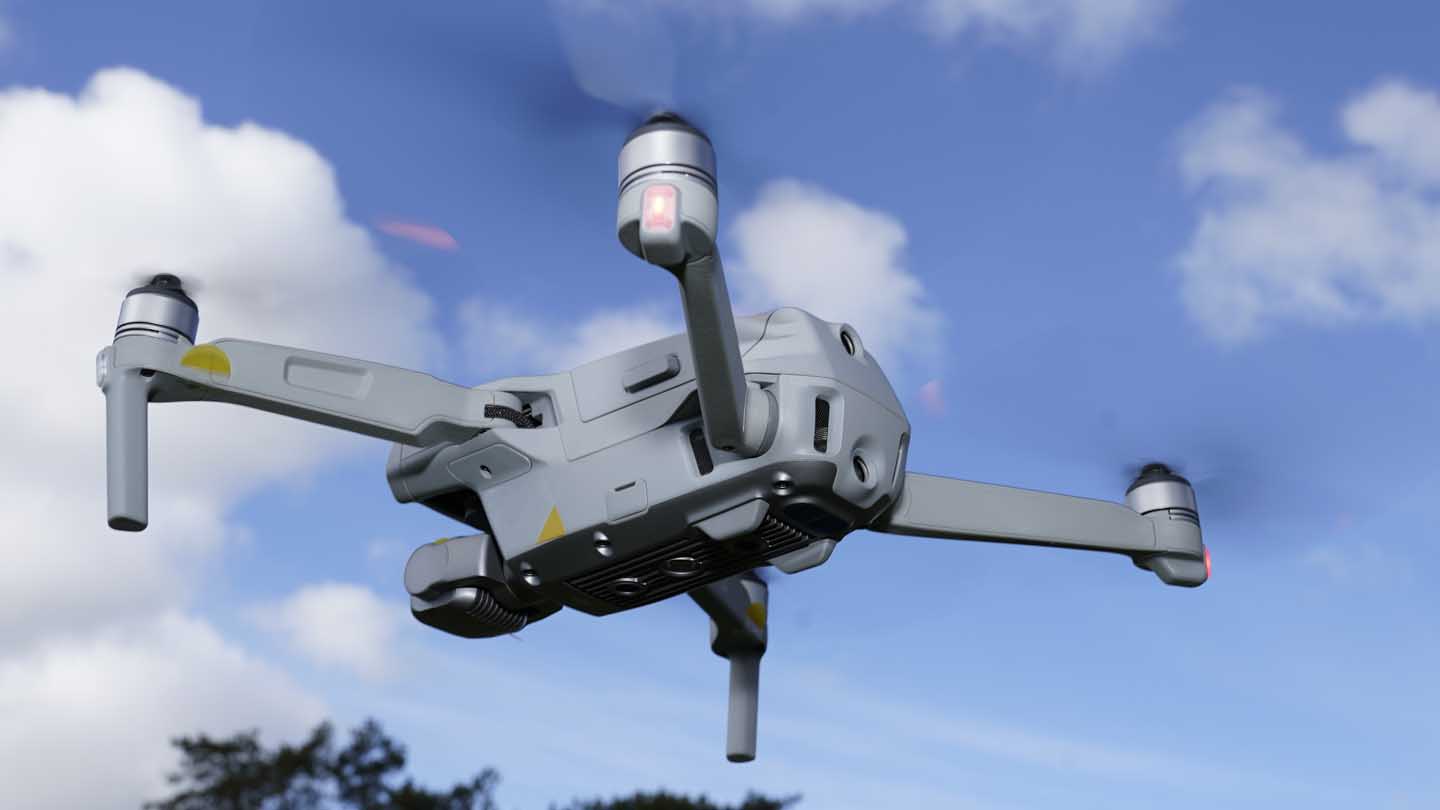
Cine Flight Mode: slow and steady
Starting in Cine flight mode and the 5m/s speed is slow, as is the movement in any direction. Flying in this mode is relatively dull as it really is all about getting the shot rather than simply flying for fun.
The slow pace enables you to track subjects easily or follow paths you mentally plot. Ultimately the Cine mode offers potential, and while you might not be able to get too close to your subject due to restrictions and the object avoidance sensors, the ability to film at 5.4k will enable you to crop into the frame in post.
Cine mode does one of two things, firstly this mode is ideal for filming; the drone’s speed and reactions are optimised to enable the capture of smooth footage through steady flight.
Filming a simple ground to air or circling an object or subject is extremely easy, and your reaction times can be slow and well-considered.
This speed also has an advantage for anyone new to flying, as all movement is slowed and restricted; it’s a great mode for getting started.
Normal Flight Mode
As the name suggests, normal flight mode enables normal flying, and the reactions and speed are ideally set for anyone used to flying but still likes the reassurance of automatic flight control.
In Normal, the flight characteristics mean that the pitch, roll, and yaw speed are all finely balanced to avoid any drift that could be caused by being overly reactive on the sticks.
This gives the DJI Air 2S a feeling that the drone is on sky rails and is extremely responsive, eliminating all of the skill that used to be required for flying.
The 15m/s flight speed is also not bad, if a little slow compared with the larger drones, but more than fast enough if you need to scope out an area looking for a scenic shot.
The difference between Normal mode on the Air 2S and Air 2 is noticeable, with the flight being far more refined and akin to the larger Phantom series.
As flight modes go, this is close to perfect, although a little more movement of the yaw would have been nice and can of course be adjusted through the Fly App.
Sport Flight Mode
Sport flight mode on the Air 2S doesn’t speed thing speed dramatically, just by 4m/s. However, it still enables quite a pace in flight and is great fun for zooming up and down a field and scoping out all the different shooting angles.
Speed, however, is not the major difference between Normal and Sports mode; that comes with the way the drone responds to movement.
Essentially most of the Normal mode’s safety is removed, and while it keeps the stabilisers on, the angle of the pitch, roll and yaw is greatly increased.
This means that you get a bit more drift if you turn too sharply, and the increase and decrease in height seems a little more responsive.
Sports mode is the one flight mode where object avoidance isn’t available, so a little extra caution needs to be paid when flying.
All three flight modes have been programmed to keep the drone in control, and even for those new to flying, there shouldn’t be any difficulties with getting to know how to fly or controlling the drone.
Object avoidance
Checking over the Air 2S and you can’t fail to see the number of sensors that now adorn the bodywork. They’re almost everywhere except for along the sides of the small drone.
This means that almost anything you do outside of sensible the drone will either stop you or beep loudly until you stop.
Compared with the early object avoidance of the Phantom 4, the Air 2S’s system is light years ahead. Try to fly it into anything, and there’s simply no chance.
In the ‘manual’ flying modes the DJI Air 2S’s object avoidance system works very well. It’s capable of spotting small twigs and generally keeps the drone safe – although be careful of very fine twigs at the top of trees.
If the ‘Obstacle Avoidance Action’ has been set to ‘Bypass’ in the DJI Fly app, the drone takes a very cautious approach. For example, when flying towards a tree it slows to a stop then creeps sideways only nudging very slowly forward once its path is clear. It will stop and move sideways again if it detects more branches.
When a QuickShot mode is activated, the app reminds you to check for objects as the object avoidance system isn’t active or isn’t as active as in manual mode. Beware of trees.
The ability to set restrictions through the Fly app, height and distance all work exceptionally well and help you keep within the rules.
On safety, DJI has worked extremely hard to ensure that the Fly App promotes safe flying and checks restricted zones and other information.
If you are in a restricted zone, it will tell you, and if you try to take off in a no-fly zone, then the drone simply won’t.
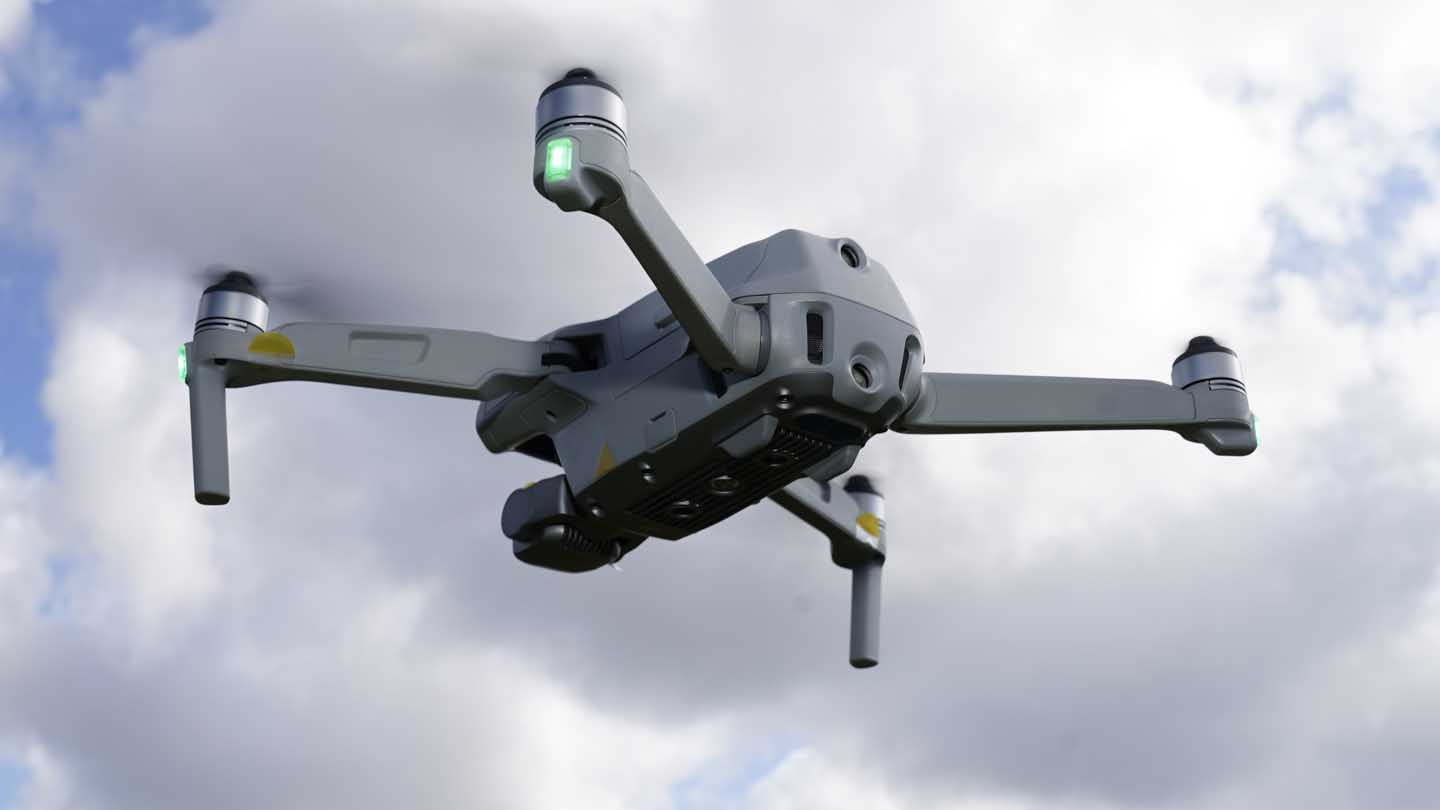
DJI Air 2S image quality
Without a doubt, the big feature of the Air 2S is its 1-inch image sensor, which is certainly impressive in such a small drone.
The increased sensor size also enables a couple of additional features which are of note. Firstly the 5.4k video resolution is the actual working resolution and the framerate of 30fps is not just a headline hitter.
What’s more important, the footage shot at this high resolution is detailed and impressive. The stills and video have plenty of impact with good dynamic range and lots of detail.
If we were to be hyper-picky, we’d mention that in some footage we shot of the Air 2S flying between the trunks of beech trees, the closer trunks sometimes look a little cutout. That’s partly because in the Normal colour mode, the sharpening is a little high, but there are no halos or major issues. And to be fair, the drone is really designed for photographing and filming distant objects rather than very close subjects.
The other feature that is noteworthy is the 8x digital zoom, which offers additional scope for the small drone. Usually, digital zooms lack quality, but the Air 2S produces impressive results.
During the test, we shot footage at all resolutions and mixed in framerates and recorded in 264/265, HDR and D-log colour profiles.
As an overall observation of the footage, and a common trait with most drone cameras, the Air 2S isn’t keen on lowlight or grey conditions. However, it fairs better than most.
Looking at the standard footage shot at 5.4k and 30fps, the clarity is generally good, but the results vary between bright and dull conditions. In bright conditions, tone, detail and colour using the standard colour profile are excellent. Plenty of detail is captured, and image quality is well balanced.
But as we mentioned, as the light level drops due to cloud, the detail and colour level drops considerably; but the quality is still well above what we have seen before.
While 30fps may seem a little slow for this resolution, DJI is the leader in mechanical image stabilisation and this helps to make 30fps clean, clear and crisp. Examining the results shot at different resolutions reveals the footage is equally well balanced.
Helpfully, the Fly More Combo kit includes ND filters that can be popped onto the lens in brighter conditions.
As the resolution increases, the sensitivity of the sensor also seems to increase and ND filters were needed to balance the exposure. This is especially noticeable when comparing footage shot a 5.4k and 1080p.
Shooting a straight vertical from ground to air shot, you can see some painterly pixelation as the sensor struggles with the information. However, as the drone rises, the clarity and impact of the image increases.
There is little to fault the quality at all video and stills resolutions.
Optically, the Air 2S’s lens also seems good and after flying it in bright sunshine, we can confirm that it’s much less prone to flare than the Mavic Air 2 and DJI Mini 2. Naturally, if the sun is very close to edge of the frame, it can still appear, but it’s not a significant issue.
One point to keep in mind with the DJI Air 2S is that the propellers sometimes appear in the footage. That’s not an issue we’ve encountered with the Air and Air 2. It may be a result of the way that the drone pitches up and down in flight more than those earlier drones. Again it’s not a major issue, but something that you may need to factor in when filming important clips.
DJI D-log is it worth it?
In recent years DJI has pushed raw and its D-log colour profile for video. With the Air 2S, the flat tone, contrast, and colour do their job, extending the dynamic range and enabling you much more scope in post. However, even in the Normal colour mode, the DJI Air 2S has dynamic range beyond the Mavic 2’s, and it manages to keep hold of highlights a bit better.
D-log is now well developed, and there are a host of LUTs that can be found from companies such as Bounce Color that you can use to draw out the best detail. We’re impressed with the D-log footage quality and any lack of detail compared with a larger drones camera is hidden due to the wow factor.
Overall, the video quality is excellent, and for small productions would be perfectly acceptable. Built-in drone cameras have come a long way in a very short amount of time.
FocusTrack
FocusTrack has a helpful collection of modes that enable you to concentrate on capturing the perfect moment(s) while the drone flies automatically. It’s selected by drawing a box around the subject on the phone screen in the controller. You’re then able to choose between Point of Interest 3.0, ActiveTrack 4. And Spotlight 2.0.
In Point of Interest mode, the drone flies around the subject automatically while in ActiveTrack 4.0 mode the drone tracks the subject and keeps it in the imaging frame. In spotlight mode, you’re in control of the direction and speed of flight but the drone turns to keep the subject in the frame.
All three modes work very well, keeping the subject nicely framed. ActiveTrack is particularly useful with moving subjects.

